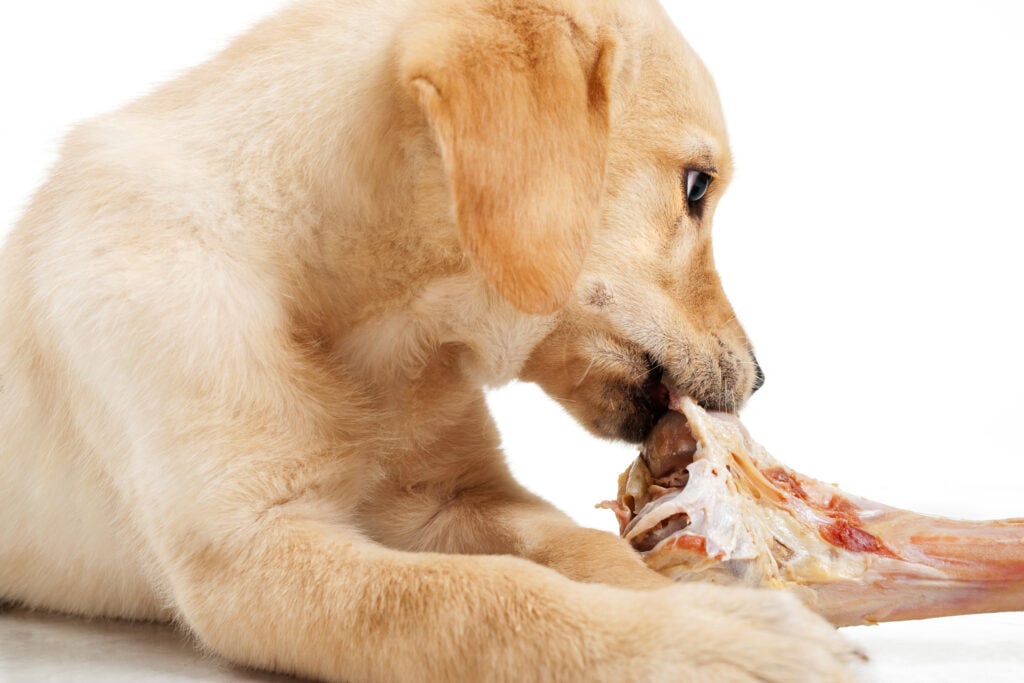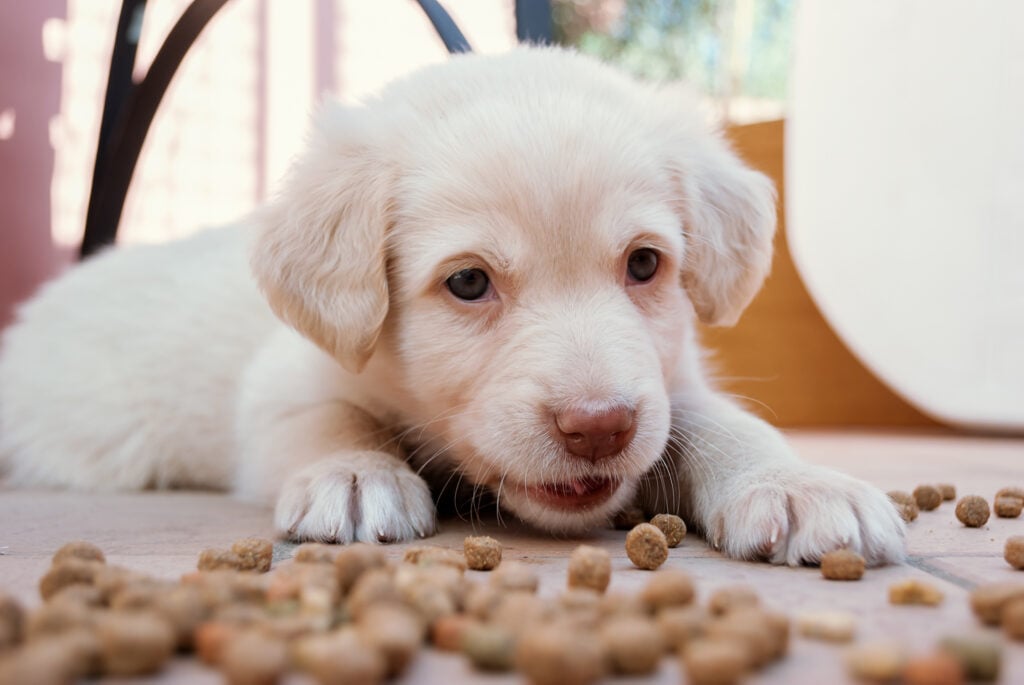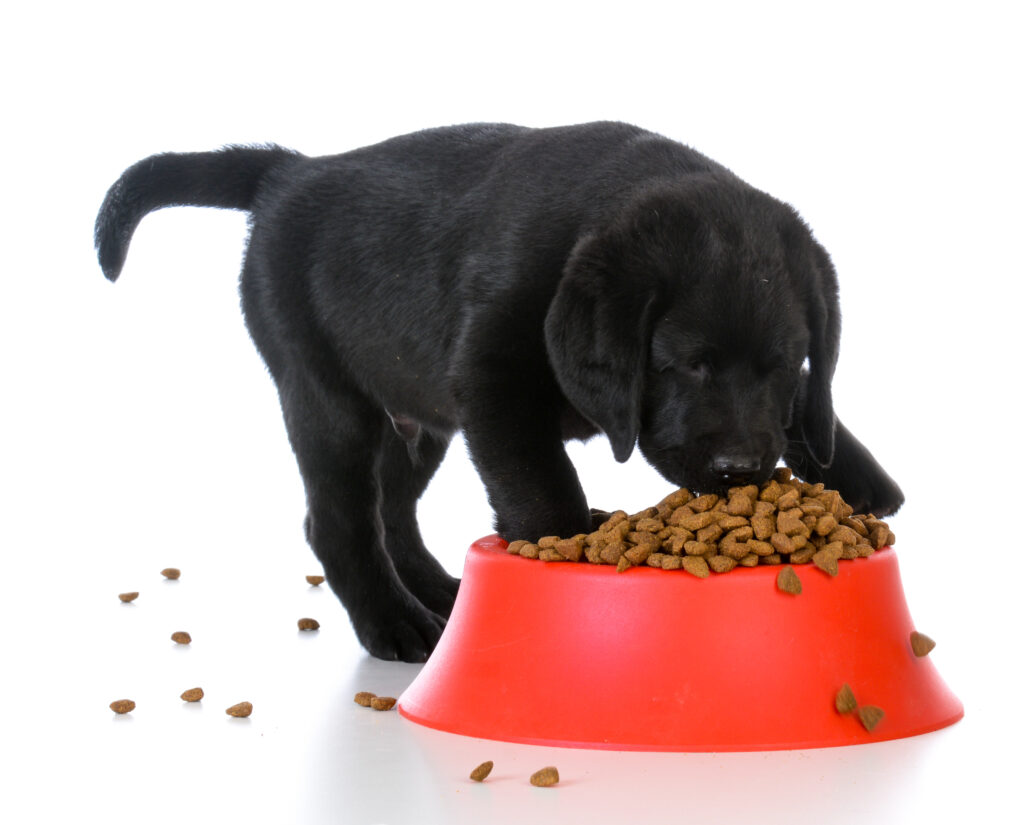Almost any lab or lab-mix owner you meet will quickly tell you they’re the best dogs; after all, everyone’s dog is the best dog! The Labrador retriever has topped the list of America’s favorite dog breeds since 1991, and it’s not hard to see why. Famously friendly, athletic, and, yes, oftentimes goofy, the lab makes an affectionate family pet and loyal working dog. With an all-around loving disposition and friendliness to humans and other animals, Labrador retrievers find themselves in a wide range of family dynamics. Your puppy is now part of your family, and you want your Lab to have the best nutrition and thrive as a member of your household.
In this article, we are going to discuss what to feed your Labrador Puppy, and discuss how much to feed a Labrador Puppy and how often, when to use Treats, and then review some highly rated puppy foods.
When considering what diet to feed your Labrador puppy, it’s always best to consult with your vet. They can help you decide the best diet for your dog, based on their breed, age, and general health. The most important things are that the diet is safe and that it meets the nutritional needs of your dog.
Table of Contents:
Puppy Food vs Adult Food: What’s the Difference?
If you’re new to puppies in general, you might find the food section of your favorite pet store a bit overwhelming. Puppy food, food specifically for large breeds, food for small breeds, food for active dogs — there is a food for every type of dog!

The word “puppy” on the dog food bag or container isn’t just marketing hype. Puppies have much different nutritional needs than adult dogs. Because of this, feeding your Labrador puppy Adult Dog Food too early will rob her of the vital nutrition she needs to grow up. You must feed puppy food to your Labrador Retriever puppy.
Canned or Bagged — or Something Else?
Even when you know you need a formula specifically designed for puppies, what type of food do you get? Dry, wet, fresh, raw? Don’t eliminate one of these choices without doing some research: you’ll find well-balanced puppy foods of each variety.
Dry food, also known as kibble, renders animal products and other ingredients into a dough that’s cooked at high temperatures to create small, hard pieces of food. While many dry foods are nutritionally balanced, the processing removes important vitamins, minerals, and other nutrients from the food. If you read the ingredient label, you notice many brands add these back in after the fact.
Wet food comes in a can or pouch. Gravy is added to ground or shredded meat to create a stew. Various types of wet food line store shelves: paté-style, chunks in gravy, and shredded are a few types of common wet foods.
Both wet and dry foods have pros and cons; this is more important as your Labrador Puppy becomes an adult. Dry foods are shelf-stable for longer after opening and aids in preventing some dental issues due to the crunchy texture and your dog’s need to chew. Wet food entices puppies — and older dogs — more due to its stronger aroma. The high moisture content in wet food adds to your puppy’s daily hydration. Puppies, particularly larger breeds, need moistened food when young. This can be mixing wet food with the dry kibble or simply adding some warm—not hot!—water to her dry food.
Wet Food Pros and Cons
| Pros | Cons |
| Highly palatable | Spoils easily |
| High moisture content to increase hydration | May lead to dental issues |
| Entices puppies to eat | More expensive per serving |
Dry Food Pros and Cons
| Pros | Cons |
| Less expensive per serving (in some cases) | Sometimes unappealing |
| Easy to store | Sometimes more difficult to interpret ingredients |
| Shelf-stable – can leave out for slower eaters | Doesn’t satiate for as long |
If you’re not sure exactly which type is best for your pet, discuss food options with your veterinarian, breeder, or the rescue agency you adopted from. Your veterinarian’s main purpose is to help you keep your Labrador Retriever puppy healthy; nutrition is the first step to a healthy dog.

Fresh Food for your Labrador Puppy
Another option gaining traction in the consumer market is fresh food. Several companies offer fresh food for dogs, taking out the nutrient-depleting cooking process for many kibbles and canned foods. Fresh food may be truly fresh or dehydrated. One promising aspect of many of these foods is you understand the ingredients list while you’re reading it instead of second-guessing what may or may not be in your lab puppy’s food.
BARF diet for your Labrador Puppy
Another alternative is the Raw Diet, also known as BARF, which was introduced by Dr. Ian Billinghurst from Sydney, Australia. You can read our article about BARF here. If you decide that you want to feed your Labrador puppy a raw diet, you will still have to feed it differently than an adult to account for the different nutritional needs of your Labrador Puppy. Before making a decision to cook your puppy’s meals or use BARF, speak with your veterinarian about the proper nutrients your puppy needs. Unfortunately, many people with the best intentions end up depriving their four-legged friend of vital nutrients.
Is the Best Food for a Labrador Puppy Grain Free?
Many puppy owners, veterinarians, and scientists believe that a grain-free diet is best for dogs, including puppies. Often, these grain-free foods have simpler labels, typically meats, meat by-products, vegetables (often peas or something similar), and added nutrients. If you choose to feed your Labrador Retriever Puppy a grain free diet, then look for foods that are marked “grain free.”
Why are There So Many Ingredients?
How to Decipher Labels and Find a Healthy Food
Reading the ingredients label on dog food can send your head spinning. What are all those ingredients, anyway? There’s much debate on the best ingredients to have in Labrador puppy food and even adult Lab food, with some owners and veterinarians swearing by different formulas.

To break down the ingredients label is to understand what certain terms mean. “By-product” and “meal” are common terms used in ingredients, but what do they mean?
By-products are the leftover, non-meat parts of slaughtered animals that go into pet food. This often includes organs and bone. This may sound unappetizing to a human, but organs often have many nutrients ideal for your Labrador puppy’s health.
Meal, on the other hand, is rendered (cooked at an extremely high temperature) to produce a stable, high-protein product. Unfortunately, “meal” has less strict requirements and may be either high or low quality.
Of course, not everyone is looking for grain free puppy food, so in more traditional foods you’ll also see plant ingredients. Determining the quality of these ingredients is equally as daunting, particularly if you’re new to the dog-feeding game. Corn, barley, and wheat commonly rank high in ingredient labels for good reason: these grains add nutrients and fiber into your Labrador puppy’s diet. Of course, they are also inexpensive compared to meat. If you are feeding food with grains, whole grains are recommended by many veterinarians because they contain more of the nutrients from the whole plant.
Dogs, including labs, can benefit from certain plant materials in their diet to round out their nutritional profile. Deciding which plants (grains, fruits, or veggies) fit best with your particular pup, consider speaking with your veterinarian on what your lab puppy might be missing.
At the end of this article we will review highly rated foods to feed your Lab puppy.
Summary Table of Some of the Best Foods for a Labrador Puppy (Article Continues Below Table)










When and how Much to Feed a Labrador Puppy?
Breakfast, Lunch, or Dinner?
Puppies eat more frequently than their adult counterparts; this is as true for labs as any other breed. Your puppy’s age is a good determining factor for how much—and how often—you feed him.
If you have a newly weaned pup between 8 and 12 weeks old, you might be surprised that the best feeding schedule is four times a day. Unfortunately, how much you feed your Labrador Puppy isn’t cut-and-dry. Each brand of food will have different feeding guidelines based on weight—and in the case of puppies, age. This is because each brand has different nutritional qualities. Don’t become frustrated when there’s a range for each factor, as well; each individual puppy’s metabolism is different, just like in humans.
Most brands will list a few age ranges for their feeding guidelines and you might be surprised to see the quantities listed change as your puppy transitions developmental stages. Oftentimes you will notice the guidelines for puppies requires more cups of food per day than adults!

The most important factor in figuring out your Labrador puppy’s ideal feeding amount is her health. Watch her as she eats and make notes of her feeding behavior. It’s not uncommon for puppies to eat more quickly than they should; this is another reason feeding smaller meals four times per day helps her get on a feeding schedule that doesn’t upset her belly. If your young Lab starts leaving food in the dish or picking at it, reduce the amount of food by a small amount (but still within the feeding guidelines), or determine if now is a good time to remove one of the four feedings and go down to three.
Determining the best feeding schedule depends greatly on your personal schedule. If you work a regular 8-hour shift, the four feedings could be right when you wake up, right before you leave, right when you get home, and an hour before bed. You don’t want to feed your puppy on a schedule that doesn’t allow them to eliminate properly outside — this can ruin your potty-training adventures!
If four meals don’t fit into your schedule, try three instead. You need a schedule that works for both you and your Labrador Puppy. As your puppy grows through different developmental stages, her needs will change. The amount of food per day will change and you can reduce her feedings to once or twice per day.
Healthy Eating Habits: How and When to use Treats
Smart, adventurous, fun-loving Labs tend to be very food-motivated. This makes training a breeze when you find the right treats to help entice your dog to follow your commands. Unfortunately, Labradors are prone to being overweight when they don’t get enough exercise or get too many treats.
If you’re treat-training your Labrador puppy using positive reinforcement methods, don’t forget to take his treat consumption into consideration with his feeding schedule. Human parents often recite “Don’t ruin your dinner!” when their children are having a between-meals snack. Not only can snacks and treats ruin your appetite for a healthier meal, but they also pack on some unneeded calories. Your Lab puppy is the same way. Take the number of treats you’re feeding during the day into account and reduce feeding amounts.
Don’t take treats for granted; they’re excellent training tools and ideal rewards for good behavior. Look for a treat that’s lower in calories and offers nutritional benefits in addition to taste. Swapping “junk food” treats for healthier options can help prevent early obesity in your puppy and lead to better health as she ages.
Activity Level and Nutrition
What Adventures do You Plan With Your Labrador Puppy?
Labs developed as a retrieving breed for hunters and fishermen in Newfoundland—yes, you read that right! They originated in Newfoundland, not Labrador. Even as the beloved family pets of today, you’ll likely notice some of his retrieving instincts as you watch your puppy play, whether you’re training him for retrieving or not.
With an outgoing personality sure to impress your inner child, your lab puppy’s activity levels will factor into your feeding decisions. Labs meant to participate in outdoor activities will require different nutrition standards as they grow from puppy to adult; many owners begin this transition around 7 to 9 months of age.
Athleticism is a trademark of Labrador Retrievers, something often overlooked of a family companion. If you plan on keeping your Labrador puppy in an active lifestyle, your choice of food may lean more to those targeted for performance dogs. The term “performance dog” relates to any sporting dog, whether hunting, dock diving, or other sports.
Health Issues: Making Sure Your Labrador Puppy Grows Into a Healthy Adult
While it’s not pleasant to think about, it’s important to understand that labs are prone to numerous health issues as they grow into adult dogs. Starting healthy eating habits when they’re young puts them on the right track for a healthier, more vibrant adulthood.
Many Labrador retrievers suffer from a plethora of allergies; one estimate puts food as 10-percent of all Lab allergies. Common food allergens for Labrador Retrievers include beef, chicken, soy, fish, or corn. Food allergies in labs often present as skin issues due to the release of histamines; you may notice red patches on your puppy, dry skin, or other forms of dermatitis.

When a Labrador Retriever has allergies, many vets will recommend an elimination diet to find what food (if it is food) is causing the reaction. An elimination diet involves removing one ingredient from your dog’s food until you find what is causing the irritation. For example, if your puppy is eating chicken-and-rice food, your vet may recommend finding food without chicken.
If you notice any of the following symptoms from your Lab puppy, contact your veterinarian to determine an elimination diet:
- Unusual or frequent scratching
- Eye discharge
- Crusty ears or ear discharge
- Hair loss
- Irritated patches
- May present as red, dry, scaly, or moist patches
Labradors are prone to a number of health issues that may become life-threatening if not treated. Starting your puppy on a healthy diet and lifestyle when he’s young may help prevent some of them. One disease common in labs is Diabetes. Diabetes is common throughout domestic dogs, but Labradors have a higher-than-normal occurrence.
As in human diabetes, diabetic labs have issues processing or creating insulin in their bodies. Insulin-resistance diabetes is common in older dogs with poor eating habits or not enough exercise. When untreated, this disease can perform a number of effects on your beloved friend, including premature death. Feeding a balanced diet and ensuring he gets enough proper exercise throughout his puppy years and adulthood helps reduce the risk of insulin-resistant diabetes.
Maintaining a Healthy Weight
How to Determine if Your Labrador Puppy is the Right Size
As if health issues weren’t scary enough, labs are particularly prone to becoming overweight due to a particular gene variation found in roughly 25-percent of Labrador Retrievers. Yes, your lab puppy might be genetically wired to be a little more food-hungry—and plumper— than desired.

Because of this, and the health needs of labs in general, maintain a healthy weight and feeding schedule. In general, you’ll be able to better tell if your Labrador puppy is a healthy weight as they grow a little closer to adulthood. As a large-breed dog, your lab puppy will remain a puppy until around 1.5- to 2-years old.
During this transition and into adulthood, you should be able to feel your lab’s ribs but not necessarily see them. If you can’t feel her ribs with a gentle rub down her side, you may need to discuss a diet plan with your veterinarian. Like humans, overweight labs will benefit from a healthier diet with increased exercise.
Fortunately, most labs have no problem finding ways to exercise—as long as their human is willing to help! Use your lab’s innate love of retrieving (fetch, anyone?) or water to help maintain that healthy weight in addition to feeding a well-balanced diet.
The Best Food for a Labrador Puppy – Products to Consider
Highly Rated Puppy Foods Currently on the Market
Although not an extensive list by any means, here are a few of the top products earning five-star reviews. Each is worth a view when deciding on the best food for your Labrador puppy. All have added nutrients and easy-to-read top ingredients. Due to your individual puppy’s health and requirements, discuss the right ingredients for a proper diet with your vet.

Blue Buffalo Life Protection Formula Natural Puppy Dry Dog Food and Puppy Wet Dog Food
Blue Buffalo prides its puppy food on always having real meat as the first ingredient and no by-product meals, as well as added antioxidants to support your Lab puppy’s immune health. Like other highly rated puppy foods, Blue Buffalo contains added vitamins, minerals, and other nutrients to support your puppy’s development.
Hill’s Science Diet Dry Dog Food, Puppy, Chicken Meal & Barley Recipe
Hill’s Science Diet has been a top contender for many years. Their puppy food is loaded with DHA and minerals to support your Labrador puppy’s development — from their brain and eyes to their bones and teeth! The ingredient list includes whole grains, as well.

Nature’s Recipe Grain-Free Easy to Digest Dry Dog Food with Real Meat, Sweet Potato & Pumpkin
This one’s a little different: you may notice the name of the product is “dog” food. Unlike other brands, Nature’s Recipe boasts a completely balanced dry food for all life stages— from puppyhood through senior! This is an ideal feature as you can keep your Labrador on the same food for his entire life. As you scan the ingredient list, you’ll notice no corn, wheat, or artificial colors or flavors. Like others, they add vital nutrients into the kibble to support your puppy’s overall health.
Purina Pro Plan High Protein Dry Puppy Food, Chicken & Rice Formula
Purina Pro Plan has several puppy foods in this line, including High Protein, Puppy Large Breed, and Puppy Shredded Blend. The antioxidant-rich formula supports your puppy’s immune system. Smaller kibble pieces make it easier for your young lab to eat comfortably (even if they tend to eat a little too quickly).
CANIDAE All Life Stages, Premium Dry Dog Food with Whole Grains
Canidae is a good dog food to have if you have several dogs in your home. It is formulated to work for all dogs ages and sizes. It is the closest thing you can get to a one size fits all dog food. However, it is not recommended for the puppies that will grow into adults larger than 70 lb.
Conclusion
Is There a Best Food for my Labrador Puppy?
The answer is yes, there is a best food for a Labrador puppy. Unfortunately, it’s not as easy as going to the store and finding a food that says “Best for Labradors.” What’s best for your lab may not be what’s best for your neighbor’s lab. Your lifestyle may not include long runs in the park or spending hours on the water, and that’s OK! Labs love their people and seamlessly fall into their lifestyles. What is important is that you understand your puppy’s needs and continuously strive to give him the best food and life you can. This may mean getting outside of your comfort zone every now and then, or it may mean getting your lab puppy out of her comfort zone!
Last update on 2022-01-11 / Affiliate links / Images from Amazon Product Advertising API


















